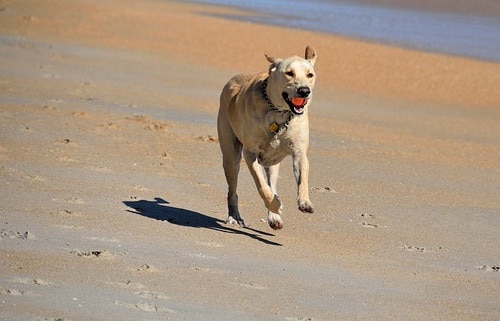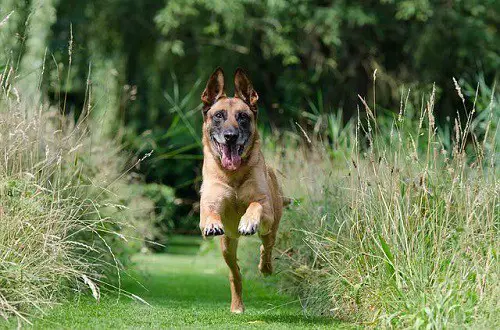Keeping your dog mentally and physically stimulated is essential for his health and happiness. That’s why you have to exercise together regularly. But overdoing it can lead to serious problems and cause more harm than good.
Overexertion is the most common result of that. If you’re an active person, you likely pushed your dog a little bit too hard sometime in the past. And then, you might have noticed some changes in him after that. If it hasn’t happened yet, it’s probably just a matter of time.

Now I see you coming with all your questions: Is it dangerous? What are the signs and symptoms? How can you treat it?… So here’s everything you should know about dog overexertion. First of all, let’s make sure everyone understands what we are talking about.
What Is Dog Overexertion?
Overexertion can occur when you push your dog too hard, physically or mentally. Just as humans, dogs have specific limits and conditions. If they go past what their body and mind can tolerate, there will be repercussions. Dog overexertion can result in pain, discomfort, injuries, and many other problems.
The main issue here is that most dogs would rather suffer in silence to keep up with their owners and do what they want than let them down. So you can’t count on them to know when it’s time to slow down. It’s your responsibility not to overexert your dog.
Is Your Dog Overexerted?
Now that you know better what overexertion is, it’s time to figure out whether or not your dog suffers from it. The best way to understand when something is wrong is through observation. You’re more likely to notice any change if you pay close attention to your dog.
Therefore, you should always watch over him before, during, and after an intense or extended effort. It will make it much easier to know if you exert your dog too much. You should always look out for signs and symptoms of overexertion.
It’s also essential to understand your dog’s conditions. Otherwise, you can’t respect them. Use your common sense to determine how much exertion is too much for your dog. Consider health, age, breed, fitness level, or anything else that might influence his tolerance and limits.
Dog Overexertion Signs & Symptoms!
After an excessive physical or mental effort, your dog’s mind and body will react a certain way. Overexertion can result in symptoms, including exhaustion, lethargy, and pain. Some signs come with it, such as excessive panting or drooling, weakness, and sore muscles.
Here’s a list of all the physical and mental features that may indicate you exert your dog too much.
Short Term:
- Excessive Panting, Drooling, or Sweating.
- Extreme Thirst.
- Fatigue.
- Not Keeping Up.
- Rapid Pulse.
- Pale Gums.
- Collapse.
- Weakness.
- High Temperature.
Long Term:
- Excessive Sleep.
- Exhaustion.
- Behavioral Changes.
- Lethargy.
- Slower To Respond.
- Muscle Soreness.
Just use your common sense. If your dog acts differently and seems more tired than usual after an intense or extended effort, it’s probably overexertion. But sometimes, it’s not that obvious. So the signs and symptoms above might help you notice it more quickly and easily.
What Can Cause Dog Overexertion?
Once you know there’s a problem, it’s time to find the source. As I already told you, overexertion can happen when you push your dog too hard. Thus, it comes from an intolerable physical or mental effort for the body or mind.
In general, overexertion in a dog is related to too much exercise. It’s normal to be exhausted after a very long hike, run, or playing session. So excessive physical activity or mental stimulation might be the problem.
The intensity and type of exercise you do with your dog are also essential considerations. Even if you keep it short, a vigorous effort can result in overexertion. So you should find ways to stay active together without pushing anyone too hard.
Ultimately, ignorance or disrespect of your dog’s conditions and limits is the real cause. Because if you know them, you will understand what his body and mind can handle. Then, you have no reason not to avoid excessive physical and mental effort.
So you should know your dog’s exercise needs and tolerance. Most dogs will do well with 30 to 60 minutes per day and can tolerate up to 1 or 2 hours. Over that, overexertion is very likely to happen. However, how much exercise is too much for a dog can widely vary according to age, breed, health, etc.
Many other elements can increase the probability of overexertion. Temperature, malnutrition, dehydration, and lack of rest will make a dog more prone to get exhausted after exercise. So make sure to consider external factors too when your dog does any physical and mental activity.
How To Prevent Your Dog From Getting Overexerted?
The best way to prevent your dog from overexertion is to avoid intense and extended effort. If you don’t push him too hard, the risks of overdoing it are low. On the other hand, lack of stimulation may reduce his physical and mental conditions and limits.
Therefore, you have to keep your dog active without doing too much. Regular exercise will allow him to build up endurance and strength. Proper nutrition can also help. A fit and healthy dog is less likely to get overexerted. Just make sure to start slow and improve gradually.
Regardless of how much you try to prevent something, shit happens. So there might be a point where you push your dog too hard, even if it’s not intentional. That’s why you should look for signs of overexertion and know what to do about it.
How To Treat A Dog With Overexertion?
The first thing you should do when a dog shows any symptom of overexertion is to stop the effort and rest. Drinking water, laying down in a cool place, and eating energy foods can also help recovery. If overexertion is too intense, frequent, or doesn’t stop, you should take your dog to the veterinarian.
Stop The Exertion!
As soon as you notice that you pushed your dog too hard, stop what you are doing now. The longer the physical or mental effort, the more harmful it can be. So your dog should cool down and stay in a relaxed position right after the overexertion.
Rest, Rest, and Rest!
After an excessive effort, your dog’s body and mind will need time to recover. Therefore, you should avoid unnecessary exercise and let him rest for as long as necessary. It will allow your dog to heal from overexertion and return to a normal state as quickly as possible.
Additional Overexertion Treatments!
Providing your dog with enough water and proper nutrition is also essential for treating overexertion. Otherwise, the body and mind won’t have the necessary nutrients and energy to recover. So please keep your dog hydrated and feed him properly after too much exercise.
Besides that, finding a safe and comfortable place to rest is also an excellent idea. For example, a crate might be the perfect environment for recovery. It’s a good spot for your dog to relax, and you can easily watch over him.
Seek Professional Help!
Finally, you can always consult your vet if needed. A professional will perform tests on your dog, find the exact problem, and provide him with the proper treatments. Overexertion might not be the cause of his unusual symptoms.
Therefore, the ultimate solution is to take your dog to a veterinarian or emergency pet care clinic. It will allow you to know more precisely what’s the problem and what to do about it. An expert can also help you avoid overexertion or that the issue in question happens again.
Last Thoughts About Dog Overexertion!
Finally, overexertion can occur in a dog after too intense or extended effort. Symptoms include excessive panting, extreme fatigue, lethargy, sore muscles, and much more. The most common cause is an exercise that the body or mind can’t tolerate.

Thus, you must know your dog’s conditions and limits not to overexert him. Pushing him too hard can lead to pain, injuries, and many other problems. But it doesn’t mean you should exercise together. Just make sure not to overdo it.
Let’s Avoid Dog Overexertion!